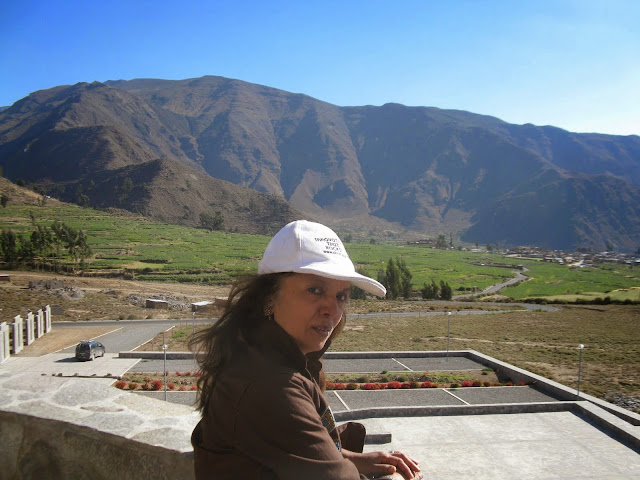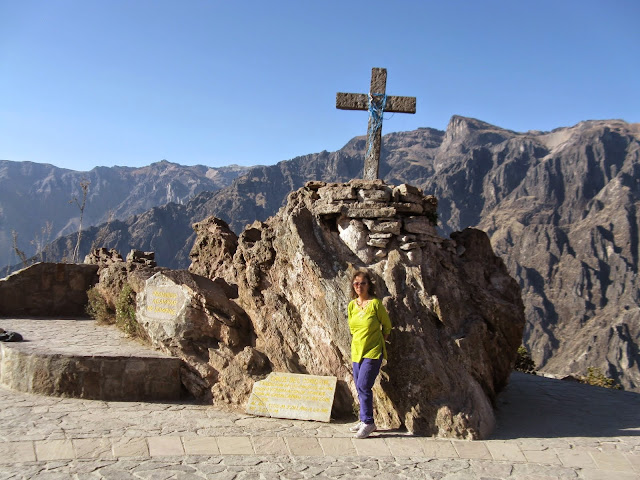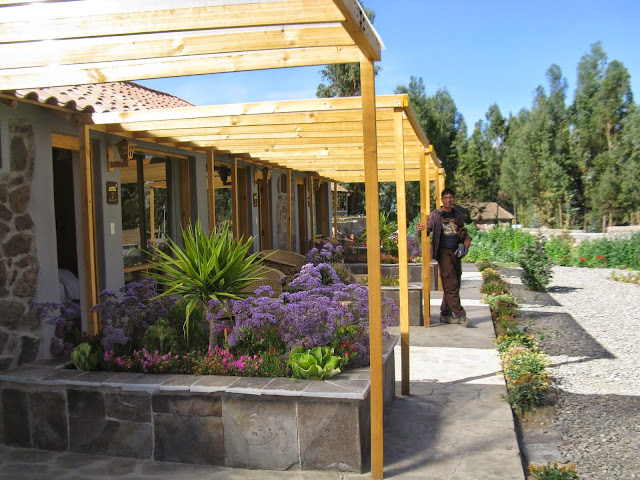DAY 10, Dec 7, 2014: Puno-Chivay-Yanque
Next on our agenda was the Colca
Canyon.

It's a detour on the way between Puno and Arequipa. Chivay, Yanque, Cabanaconde are the main bases here. We decided to stay at Yanque. Most people come to Colca canyon as day trip but we felt that would be too hectic and decided to stay for 2 nights at Yanque. Again most stay for just one night.

It's a detour on the way between Puno and Arequipa. Chivay, Yanque, Cabanaconde are the main bases here. We decided to stay at Yanque. Most people come to Colca canyon as day trip but we felt that would be too hectic and decided to stay for 2 nights at Yanque. Again most stay for just one night.
Took the 4M Express bus from Puno to
Chivay. Got picked up at hotel at 6 am, put on a van with 2 others. We
got a considerable discount as we had emailed them. This is the map of our bus route.
We reached our 1st stop, Lagunillas
Lake, located in the department of Puno at about 4174 masl.

This is a good place to appreciate more of the region's fauna, consisting of ajoyas, chocas and especially flamingos.

This is a good place to appreciate more of the region's fauna, consisting of ajoyas, chocas and especially flamingos.
The lake Lagunillas with the Sillapaka
mountain range in the background, Lagunillas is a high Andean lake or lagoon located in the Peruvian department of Puno, at an altitude of 4,174 meters. Its dimensions are 18.6 kilometers long and 5.8 kilometers wide and a maximum area of 66 km² with a maximum depth of 47.6 meters. It has four small islands.
Our van behind...
Then we saw the Great Imata Stone Forest from a distance
Then we saw the Great Imata Stone Forest from a distance
Then we went on our way to Pampa Cañahuas, which is part of Salinas y Aguada Blanca National Park, a wildlife reserve for South American camelids such as the vicuña, which has been hunted almost to extinction due to its fine and soft wool.
Mirador de los volcanes:
Going on with the journey we crossed over Chucura Volcano, where we saw a number of small volcanoes between ichu-covered plains.
Patapampa:
At around 4800 meters above sea level is located Patapampa, which is the highest point of our tour between Colca Valley and Puno. This altitude makes Patapampa a natural outlook point where travelers can see volcanoes and snow-covered mountains such as Sabancaya, Ampato, and Mismi. In Patapampa, it is possible to find stones that are piled on top of each other by travelers and locals. It is part of a ritual related to rest and strength to continue the trip. It is also believed to provide protection, health and permission to enter somewhere new.
Entrance to Colca canyon region...
we have to buy an integrated ticket (boleto integral) for 70 soles to all the hikes in the region here.
we have to buy an integrated ticket (boleto integral) for 70 soles to all the hikes in the region here.
Reached Chivay 3600 masl. , the last
point on the bus trip. The main square was cordoned off. Susannah of
4M Express helped us get a cab to Yanque for 20 soles.
Killawasi lodge, Yanque:
At Killawasi Lodge, our hotel in
Yanque... checking in with Guillermo, the owner.
There was a free guided hike of the
nearby ruins in the evening for all hotel guests...just one family besides us... here's the guide and the Peruvian girl from Lima. Her Dad was feeling the effect of altitude sickness and did not join
Yanque village square .
local dance in the morning
. Our hotel had arranged a tour... a van with a guide.
2 guys staying at the pricey Casa del inca... $350/night joined us on the tour.
local dance in the morning
. Our hotel had arranged a tour... a van with a guide.
2 guys staying at the pricey Casa del inca... $350/night joined us on the tour.
The Colca Valley is extremely deep and
picturesque. It is formed by the Colca River; surrounded by huge
mountains, small villages, interesting market places, colonial
churches, and green agricultural terraces hugging the hillsides with
herds of wandering llamas.
The Colca Valley is 124 miles long and 11,155 feet deep. It's Colca River is a popular "White Water" rafting spot with a world wide reputation.
The region takes its name from the qolqas (colcas) that are found throughout the valley, mud and stone granaries built into cliffs or caves where the dry, cool climate makes for an ideal "refrigerated" storage for crops or seeds. (These can be seen at various places throughout the valley, but most easily at the "Puente Sifon" in Yanque.)
In the late 14th century, the Inca arrived, taking the Colca valley into their empire through intermarriage. They helped to perfect the construction of irrigation channels and terraces, and their influence is visible, too, in the stonework of some of the archeological sites.
With the Spanish conquest in the 16th century came the "Toledan reductions," in which the local governor demanded that the population be concentrated in a few major towns throughout the valley, instead of dispersed in their small settlements. This was the origin of most of the towns that are found today. The churches in each town were mostly built between the 16th and 19th centuries.
"Cruz del Condor" lookout point:
Located between Maca and Cabanaconde, where the winds are stronger, is the "Cruz del Condor" lookout point. It is the most popular viewing point from which to see the Colca Valley and it is also a good place to see the giant condors soaring on their incredible wingspans above the depths of the canyon below.
Because the valley is very deep, the rising winds are strong and the condors in the area, take advantage of these winds to soar gracefully into the sky.
Colca river winding its way in the canyon

Mirador del condor:
Eagle in flight at colca canyon.
Then the condors started to rise...
2 condors soaring in the sky...it was really good in person and they swopped right past our heads... AWESOME
Then the condors started to rise...
This is some crop...

Maca is a small village between the Cruz del Condor and Chivay. Situated at the base of Sabancaya volcano on a fault line, it has suffered numerous earthquakes and ashfalls since the volcano resumed activity in 1986 after a two hundred year hiatus.
Tuna fruits in the tray... bought 3.
Also known as prickly pear, tuna is similar to tumbo as they're both cactus fruits. It's bright pink or green with prickles on the outside and bright pink with black edible seeds on the inside. The inside is like the tumbo. Available January to March and at three tunas for 1 sol. It tastes like watermelon, raspberries, and kiwi all rolled into one.
We returned to the hotel after the tour, Tipped our nice guide...
Had some food and the tuna fruit... pretty good!

Usually people leave the village after the tour. But we were staying that night to explore the neighborhood. We asked the hotel owner for a cab to drive up to Cabanaconde and do a bit of hike into the canyon. He quoted a sum which was high. We walked over to the village square, talked to the drivers therein our broken Spanish and fixed a return trip for a much lower sum.
So here we are ... after the drive on the same road we had come in the morning we went further ahead up to the last village on the road and hiked a bit into the canyon. There's a 3 day hike into the canyon having night halts in villages... we just wanted a small sample.
Village visible as green patch...
Great views and it was surreal having the whole place to ourselves...
We returned to the hotel after the tour, Tipped our nice guide...
Had some food and the tuna fruit... pretty good!

Usually people leave the village after the tour. But we were staying that night to explore the neighborhood. We asked the hotel owner for a cab to drive up to Cabanaconde and do a bit of hike into the canyon. He quoted a sum which was high. We walked over to the village square, talked to the drivers therein our broken Spanish and fixed a return trip for a much lower sum.
So here we are ... after the drive on the same road we had come in the morning we went further ahead up to the last village on the road and hiked a bit into the canyon. There's a 3 day hike into the canyon having night halts in villages... we just wanted a small sample.
Village visible as green patch...
Great views and it was surreal having the whole place to ourselves...
CABANACONDE:
Then we asked the driver to drive us back... we stopped at the village center at Cabanaconde.

These are plaques for each village with specific icons carved out on each...Chivay here...
Yanque here...


The circular drum is the office building. We climbed up and had great views.

All village plazas have a statue... condor here...

We walked through the village and saw their fields


The circular drum is the office building. We climbed up and had great views.


We walked through the village and saw their fields
Then we drove back... passing the miradors on the way. Now so deserted as opposed to the crowd in the morning...
Condor on the ground...
We paid the driver when we returned.
Had a meal at our room
Day 12 MORNING, Dec 9, 2014:
Yanque , Chivay:
We walked down to Yanque plaza again and visited the church


Yanque village plaza
Bird topiary...
At our hotel entrance...
Explored the hotel
, had our tuna fruit and waited around for our van which was scheduled at noon
CHIVAY:
Met up with Susanna who had been our guide on the 4MExpress trip from Puno to Chivay. Kept our bags with her and explored Chivay for a few minutes till our van took off. There was a religious parade...
Note the Cross etched on the hill behind.
Peruvian autorickshaws.
Our Arequipa report is here:
http://adventuretrav.blogspot.com/2017/06/peru-trip-report-day-12-yanque-chivay.html























































































































































































No comments:
Post a Comment